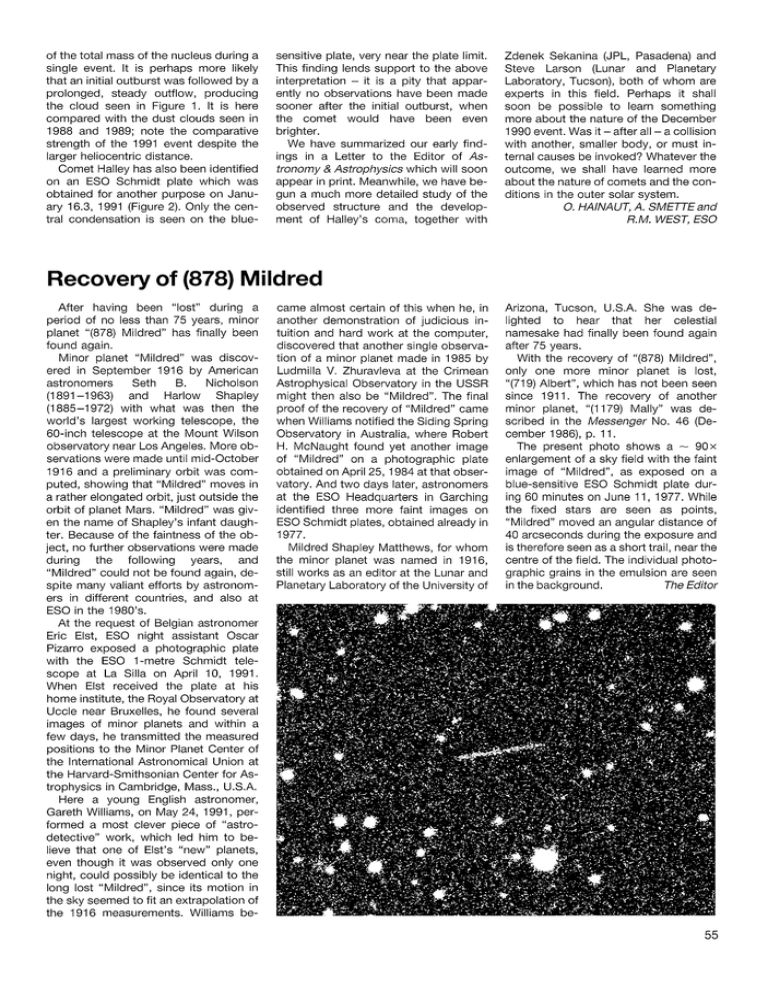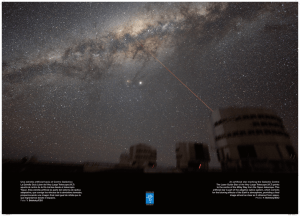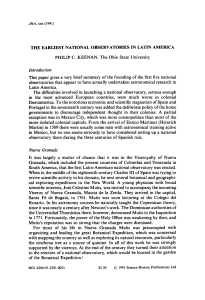Recovery of (878) Mildred
Anuncio

of the total mass of the nucleus during a single event. It is perhaps more likely that an initial outburst was followed by a prolonged, steady outflow, producing the cloud seen in Figure 1. It is here compared with the dust clouds seen in 1988 and 1989; note the comparative strength of the 1991 event despite the larger heliocentric distance. Comet Halley has also been identified on an ESO Schmidt plate which was obtained for another purpose on January 16.3, 1991 (Figure 2). Only the central condensation is seen on the blue- sensitive plate, very near the plate limit. This finding lends support to the above interpretation - it is a pity that apparently no observations have been made sooner after the initial outburst, when the comet would have been even brighter. We have summarized our early findings in a Letter to the Editor of Astronomy & Astrophysics which will soon appear in print. Meanwhile, we have begun a much more detailed study of the observed structure and the development of Halley's coma, together with Zdenek Sekanina (JPL, Pasadena) and Steve Larson (Lunar and Planetary Laboratory, Tucson), both of whom are experts in this field. Perhaps it shall soon be possible to learn something more about the nature of the December 1990 event. Was it - after all - a collision with another, smaller body, or must internal causes be invoked? Whatever the outcome, we shall have learned more about the nature of comets and the conditions in the outer solar system. 0. HAINAUT, A. SMETTE and R.M. WEST, ESO Recovery of (878) Mildred After having been "lost" during a period of no less than 75 years, minor planet "(878) Mildred" has finally been found again. Minor planet "Mildred" was discovered in September 1916 by American astronomers Seth B. Nicholson (1891 -1 963) and Harlow Shapley (1885-1 972) with what was then the world's largest working telescope, the 60-inch telescope at the Mount Wilson observatory near Los Angeles. More observations were made until mid-October 1916 and a preliminary orbit was computed, showing that "Mildred" moves in a rather elongated orbit, just outside the orbit of planet Mars. "Mildred" was given the name of Shapley's infant daughter. Because of the faintness of the object, no further observations were made during the following years, and ''~ildred"could not be found again, despite many valiant efforts by astronomers in different countries, and also at ESO in the 1980's. At the request of Belgian astronomer Eric Elst, ESO night assistant Oscar Pizarro exposed a photographic plate with the ESO 1-metre Schmidt telescope at La Silla on April 10, 1991. When Elst received the plate at his home institute, the Royal Observatory at Uccle near Bruxelles, he found several images of minor planets and within a few days, he transmitted the measured positions to the Minor Planet Center of the International Astronomical Union at the Harvard-Smithsonian Center for Astrophysics in Cambridge, Mass., U.S.A. Here a young English astronomer, Gareth Williams, on May 24, 1991, performed a most clever piece of "astrodetective" work, which led him to believe that one of Elst's "new" planets, even though it was observed only one night, could possibly be identical to the long lost "Mildred", since its motion in the sky seemed to fit an extrapolation of the 1916 measurements. Williams be- came almost certain of this when he, in another demonstration of judicious intuition and hard work at the computer, discovered that another single observation of a minor planet made in 1985 by Ludmilla V. Zhuravleva at the Crimean Astrophysical Observatory in the USSR might then also be "Mildred". The final proof of the recovery of "Mildred" came when Williams notified the Siding Spring Observatory in Australia, where Robert H. McNaught found yet another image of "Mildred" on a photographic plate obtained on April 25, 1984 at that observatory. And two days later, astronomers at the ESO Headquarters in Garching identified three more faint images on ESO Schmidt plates, obtained already in 1977. Mildred Shapley Matthews, for whom the minor planet was named in 1916, still works as an editor at the Lunar and Planetary Laboratory of the University of Arizona, Tucson, U.S.A. She was delighted to hear that her celestial namesake had finally been found again after 75 years. With the recovery of "(878) Mildred", only one more minor planet is lost, "(719) Albert", which has not been seen since 1911. The recovery of another minor planet, "(1179) Mally" was described in the Messenger No. 46 (December 1986), p. 11. The present photo shows a 90x enlargement of a sky field with the faint image of "Mildred", as exposed on a blue-sensitive ESO Schmidt plate during 60 minutes on June 11, 1977. While the fixed stars are seen as points, "Mildred" moved an angular distance of 40 arcseconds during the exposure and is therefore seen as a short trail, near the centre of the field. The individual photographic grains in the emulsion are seen in the background. The Editor -



